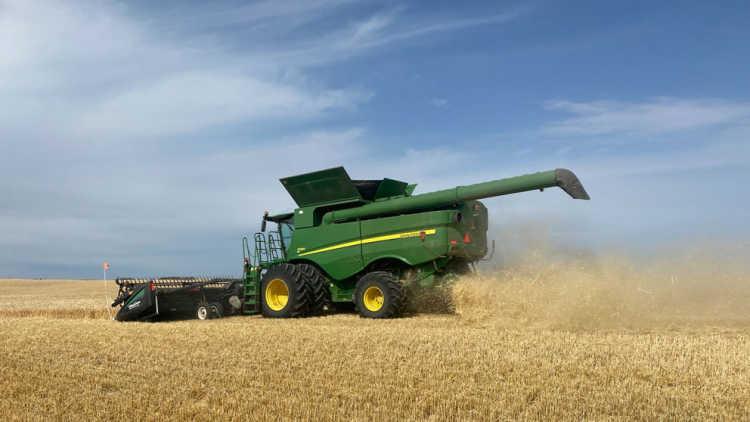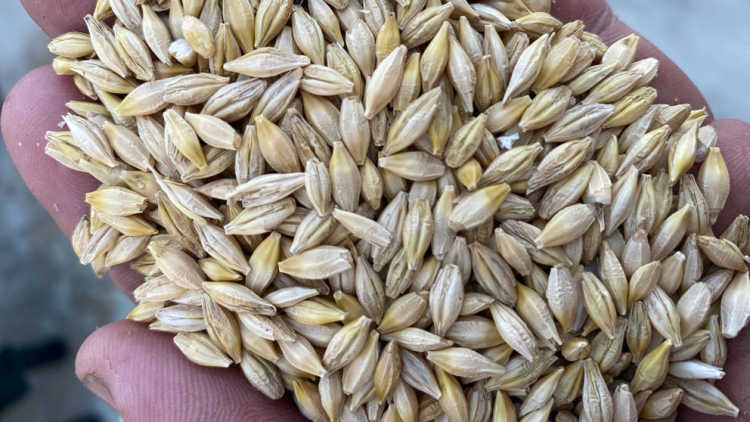Alberta’s craft beer supply chain: The producer at the helm (Part 4)

COVID-19 took a toll on almost every Alberta manufacturing sector last year. This 4-part series describes the economics behind one of Alberta’s many barley-to-beer supply chains. We explore how craft beer’s unique ties to its consumers were able to shield it from some of the damage wrought by COVID – and how far the pandemic’s impacts reached.
Post 1 describes the shift in the supply chain that put consumers in the driver’s seat of craft beer.
Post 2 explains how a demand-driven supply chain was uniquely situated to withstand some of the effects of COVID.
Post 3 explores the role of the maltster as the indispensable conduit between craft brewer and barley producer.
Post 4 illustrates how much influence COVID had — and didn’t have — at the farm of a barley producer with close ties to an Alberta maltster.
In the spring of 2020, Sheldon Stang wasn’t worrying too much about the news of a global pandemic. The Saskatchewan producer was busy preparing the next crop on his family’s grains and oilseeds operation. COVID seemed a world away

Barley harvest, 2020 on the Stang family farm near Kerrobert, SK.
Located close to the Alberta-Saskatchewan border, Stang farms about 8,800 acres with his parents Gord and Sharon and wife, Aimée Ferré Stang. In 2020, the Stangs grew roughly 2,000 acres of malt barley, most of it to meet a production contract with Rahr. They’ve worked with Rahr for 10 years.
Why barley?
Other grains can be used to malt and brew beer, but barley has always been the favourite. Even wheat beer is made with more than 50% barley.
Maltsters and brewers prefer barley’s unique features:
Lots of natural enzymes used to convert starches into sugars for fermentation
Retention of the grain's protective husk, even after threshing (unlike seeds of threshed wheat or rye) making it easier to malt
A hard, outer shell that assists in the stage of the brewing process designed to create clarity
Moderate levels of proteins that allow for increased foam stability and greater mouth feel
Stang and other producers had already made the major production decisions for the 2020 crop in the fall of 2019. Alberta and Saskatchewan offer ideal conditions for growing excellent quality malt barley.

Raw barley from the Stang family farm, 2020.
A climate with hot days and cool nights means fewer pesticides and pre-harvest chemicals while optimizing storage conditions. That’s important for a producer’s bottom line on a crop like malt barley, which can require more pest control and other expensive inputs than feed barley, its closest cousin. No surprise then that about 95% of Canada’s 2020 barley production, estimated at 10.4 million metric tonnes (MT) in 2020, came from the prairies.
As COVID was dominating the airwaves in the spring and early summer months, Stang monitored the progress of his different crops. The malt barley he had seeded to fulfill his contracted deliveries with Rahr throughout 2020-21 was in excellent shape. It looked like a great year ahead.
An outright market failure
The farm wasn’t immune to COVID’s influence, however. With U.S. brewery customers shutting down or slowing their production in response to public health measures, Rahr’s requests for deliveries of the Stangs’ 2019 crop started to slow. From a purely economic perspective, COVID was producing an outright market failure in the beer sector. All markets rely on the free flow of accurate information along supply chains to work properly. And under the weight of mass closures and mandated restrictions of taprooms and restaurants, supply chain participants didn’t know if or when consumers were willing and able to buy beer.
Producers locked into production contracts faced critical decisions: they could wait for Rahr’s bids, not knowing what the price might be, or back out of their contracts and look to sell the grain elsewhere. The Stangs were willing to wait for the malthouse’s orders to pick back up. Harvest of the 2020 crop was still months away, and Rahr covered the cost to the family of storing 2019’s contracted grain on the farm – to the end of August if needed. They could afford to assume there would be time to deliver the grain out of storage before the new crop came in.
The Stangs were taking a chance they’d receive a price for their grain close to what they’d contracted before COVID wiped out markets and lowered prices. It was the strength of their relationship with Rahr that gave them the confidence to wait it out. But fair, reliable pricing of malt barley, normally determined by the market’s knowledge of both supply and demand factors, was reduced largely to guesswork in the pandemic.
Market supply and demand dictate prices - but what if there are no markets?
Barley, unlike other grains, is not traded on an exchange. There are no futures on which to objectively base contracts. Instead, Rahr calculates a fair market price to offer the 200 producers in their direct producer contracting program. Tracking grain and oilseed prices, they compute likely revenues and costs per acre, and offer prices that allow Rahr and their producers to meet their margin targets. It’s fair, transparent – and it fell apart in the first wave of the pandemic.
“Most times, Rahr has led the market [in pricing],” says Stang. “In the last year and a half, they haven't. Other contracted producers, preferring not to wait for Rahr’s orders to start again, knew they could get better prices in other higher-priced markets occurring elsewhere. In 2020, that was a very active export market.
Crop markets in 2020: a race to the top
Typically, about one-third of Canada’s malt barley production is used by the domestic brewing industry while the balance is exported, primarily to the U.S. and Asia. But barley offers two distinctly different markets. Malt-quality barley used to make beer is a high-end commodity. Feed barley is used to feed livestock. Malt normally sells for a premium because of that quality and because it’s more difficult to grow than feed barley.
With a reputation for quality crops, Canada supplies about 10% of the world’s needs, exporting feed and malt barley and finished malt to the U.S., China, and Japan, among others. Two forces upended typical global trade patterns in 2020. The first was unexpected demand for raw commodities like wheat and other grains from countries concerned about food security during the pandemic. The second was China’s seemingly insatiable demand for grains and oilseeds used primarily as feed grains. Together, they rocketed commodity prices higher and higher. They were Stang’s “saving grace,” he says. “China really helped with pricing. Had it not been for that, I think we would have been a lot more directly affected.”
That’s because, during COVID, the feed-malt barley price premium shifted. Barley producers unable to sell their malt barley to Canadian maltsters could turn to export feed markets instead and get similar, and sometimes better, prices. Last year, Stang and many others sold more malt-quality barley into feed markets than they normally would, and they still did just fine on pricing.
Stang says, “Did I maybe give up a little bit pricing my barley through Rahr? Probably. But have they provided me with lots of long-term opportunities in the past? Absolutely. So yeah. I mean, to fault them for being 20 cents or 15 cents a bushel lower in the marketplace today when they've had a really difficult time - and for me to walk away from them? That's not a long-term partnership.”
“I don't want to build my farm's relationships on marketing barley around China. “They're very, very in and out. Today they're here. Tomorrow they're gone.” Banking on a third party who is acting only in their own interests isn’t sustainable for Rahr or Stang. For him, a production contract is a risk mitigation tool in a bad year, and it can be a limiting factor in a good year.
“Our deals with Rahr, you can't just look at it from a short-term perspective,” Stang says. “They've been profitable for us for multiple years. You still have to work together when they’re struggling.”
The barley producer and the craft consumer
This series explores a consumer-driven supply chain through a glimpse into one of the many barley-to-beer chains in Alberta. After historical beer production trends led to two very different global beer markets, a movement focused on craft catapulted the consumer into the driver’s seat, shifting the “push” of a supply-driven supply chain to the “pull” of a demand-driven chain.
But the world changed fundamentally in 2020. To operate properly and allow supply chain players to make rational decisions, information about supply and demand is needed. COVID interfered with the free flow of knowledge about customers’ intentions and ability to consume craft beer – but not equally across the various players acting in the same chain. Many small businesses in mid-central Alberta were able to avert disaster after provincial legislation allowed for home delivery and off sales. They could once again make rational decisions about markets because they were given good information about consumers’ likely behaviour. It worked. After an initial lull, the pandemic amplified the pre-existing move to support local. Breweries like Troubled Monk and Blindman Brewing, retailers like Cilantro and Chive and small specialty maltsters like Red Shed could resume business, supporting their local supply chains and helping to make and sell great beer.
Rahr Malting couldn’t access reliable information about their key U.S. customers until much later in the pandemic. At the same time, they were forced to compete with the escalating prices of strongly energized barley export markets. Unable to confront them head-on, Rahr had to shut down production and allow producers to walk away from contracts. That option made sense to some producers, but not to Sheldon Stang.
The value he found in staying with Rahr — waiting to deliver his 2019 crop until much later in 2020 and holding onto 2020 crop later than normal — more than offset the additional costs of storing the grain and the lost opportunity costs of selling more grain into the booming export markets.
What it all means
Regardless of its location or proximity to supply, consumer demand spurs all supply responses. COVID only underscored the importance of the consumer and the importance of knowledge about the consumer for one particular craft beer supply chain in Alberta. In a year like no other, consumers didn’t — couldn’t — know how to spend their money. It was the sort of market interference that will have ripple effects well into 2021 for every supply chain participant.

Martha Roberts
Economics Editor
Martha joined the Economics team in 2013, focusing on research insights about risk and success factors for agricultural producers and agri-businesses. She has 25 years’ experience conducting and communicating quantitative and qualitative research results to industry experts. Martha holds a Master of Sociology degree from Queen’s University in Kingston, Ontario and a Master of Fine Arts degree in non-fiction writing from the University of King’s College.
